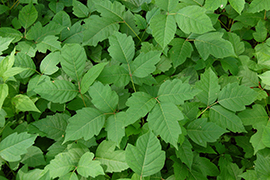Identifying Poison Ivy
A rash, red blisters and uncontrollable itching – people who have been impacted by
poison ivy are familiar with what it can do. Those fortunate enough to not have encountered
the plant should know how to recognize and avoid the same fate. 
“It’s important to understand the difference between a simple leaf and a compound
leaf,” said Karen Hickman, professor and director of the environmental sciences program
at Oklahoma State University. “Simple leaves are made up of a blade and the petiole,
which is the stalk that attaches the leaf to the stem. You can usually find a little
bud where the stalk meets the stem.”
In contrast, a compound leaf is made of several leaflets along the petiole. The entire
structure, from the stem to the end of the leaflets, is one leaf. Poison ivy falls
into this category.
Poison ivy is a trifoliate compound leaf, meaning it has three separate leaflets.
The two lateral leaflets will jut out of the petiole with the terminal leaflet coming
straight out the top.
“The old adage, ‘leaves of three, let it be,’ isn’t exactly accurate,” Hickman said.
“Maybe adopting the idea of, ‘leaflets of three, let it be,’ would be better.”
Poison ivy can grow as sparsely branched shrubs, as a shrub in a thicket, a ground
cover and in vines, allowing it to climb up trees. It can grow in full sun or in shade.
It has pale green leaves or dark leaves, and the size of leaves can vary greatly.
Leaflets can have smooth outer edges or be very jagged in their appearance.
“Being able to identify poison ivy isn’t always the easiest thing in the world to
do because of the variations in size, shape and location,” Hickman said. “But one
thing you can know for sure is the plant is going to have three leaflets, and it is
going to itch like crazy if its oil gets on your skin.”
Do not confuse poison ivy with imposters
Misidentifying other plants as the itch-causing agent is common, according to Dwayne
Elmore, OSU Extension wildlife specialist, who said the Virginia creeper is one of
the most commonly mistaken plants.
“This vine grows throughout Oklahoma and the eastern United States. It can be found
in forests and prairie edges where it is often mistaken for poison ivy,” Elmore said.
“While both plants are vines, they can be readily distinguished as poison ivy has
three leaflets and Virginia creeper has five.”
Both plants play an important role to wildlife, serving as both food and nesting to
deer and birds.
The Virginia creeper is also a wonderful landscape plant and can grow in both deep
shade and full sunlight, said Elmore. In the fall season, it often provides a brilliant
splash of color before dropping leaves for the winter. The vine can be vigorous when
well-watered, making the plant a good choice as a ground cover or for arbors and trellises.
It is also drought and heat tolerant and will grow in a wide variety of soil types.
Another plant commonly mistaken for poison ivy is boxelder. The boxelder plant is
actually a tree but looks very much like poison ivy when it is young. Boxelder leaves
come out at the same spot, whereas poison ivy and poison oak leaflets are staggered.
As boxelder becomes older, it grows more leaflets and becomes distinguishable from
poison ivy.
